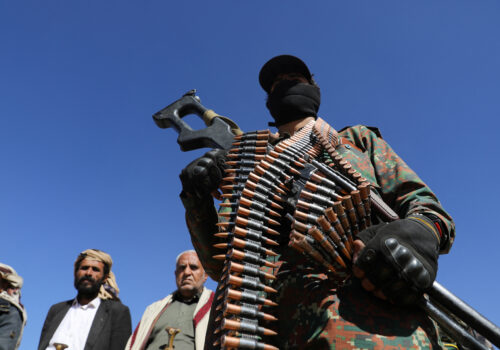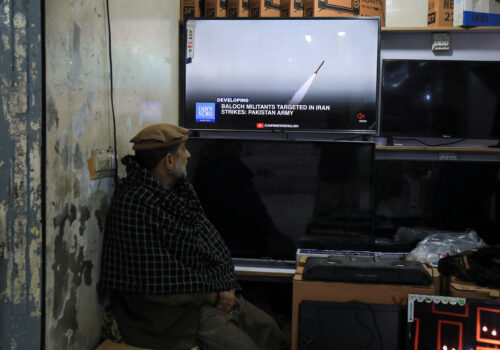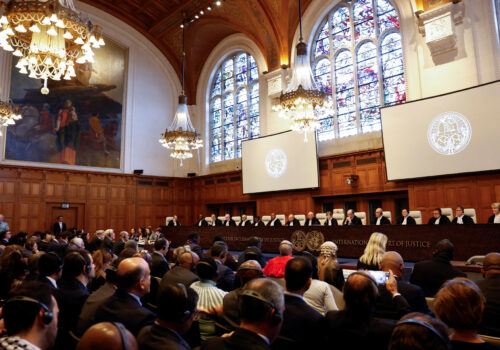Experts react: Three US servicemembers were killed in Jordan. Will the US strike back at Iran?
The escalation continues. A drone attack on a US outpost in northeastern Jordan on Sunday killed three US servicemembers and injured dozens more. Since October 7, 2023, when Hamas launched its terror attack on Israel, there have been more than 150 rocket, missile, and drone attacks on US forces in the Middle East, but the strike overnight was the first to kill a US soldier. In a statement on Sunday afternoon, US President Joe Biden said that Iran-backed militant groups operating in Syria and Iraq were responsible. Below. Atlantic Council experts put the strike in context and explain how the United States should respond.
Click to jump to an expert analysis:
Jonathan Panikoff: It’s time to take on the threat from Iran—not just its proxies
Matt Kroenig: The US could hit back against Iran’s navy, top leadership, or nuclear program
Nathan Sales: Stop self-deterring and take the gloves off with Iran
Daniel E. Mouton: The US needs to step up its UAV defenses and hold Iran accountable
Matthew Zais: This attack is the result of the United States’ failed ‘one-Iraq’ policy
It’s time to take on the threat from Iran—not just its proxies
Tower 22, where three US servicemembers were killed and dozens injured in a drone attack, sits on the Jordanian side of the border with Syria and only a few kilometers from the Iraqi one. The attack almost certainly reflects an increased risk tolerance by Tehran in its effort for influence and control in the region. Unlike the Houthis, who have their own agenda and Iran lacks full control over, Syrian and Iraq-based Shia militants are largely responsive to Tehran and would be unlikely to carry out such an attack without at least the implicit support and approval of senior Islamic Revolutionary Guard Corps (IRGC) leaders. Therefore, the broader challenge for the Biden administration is going to be how to address the Iranian threat, not just the Shia militant one emanating from Iraq and Syria.
Iran’s leadership probably calculates that the United States will be reticent to fulsomely respond in any manner that would risk escalation of tensions in the Middle East and spark the region-wide war the Biden administration has admirably tried to prevent over the past three months. But with the death of multiple US service members, the Biden administration will need to reconsider its stance and decide whether hostilities have now crossed the Rubicon and the United States is already in a regional conflict.
The natural conclusion is that this will not be the last attack on US forces. There is strong evidence for such a determination. Consider the pattern so far: first, the plethora of recent Houthi attacks against US and allied targets—which led the United States, once it ran out of patience, to put together the counter-Houthi Operation Prosperity Guardian; second, attacks injuring US forces by Iraqi Shia militants as recently as last month; and now, third, an attack by Shia militants on US forces in Jordan.
What’s different in this case, marking a further escalation, is that Jordan, unlike Iraq and Syria, is not host to Iran-backed Shia militant bases. Unless evidence is produced that the drone attack was a mistake or an accident, both highly unlikely, then this was an attack on not only US forces but also on the Hashemite Kingdom of Jordan, a critical US ally.
The determination that we’re now in a regional conflict, in which US troops are likely to continue to be under threat, would require US policymakers to undertake a more fulsome response to restore deterrence. Iran has shown time and again a willingness to put its Arab partners and proxies at risk, but not the same willingness for the country’s own forces and security to be in jeopardy. Israel and Iran have long been engaged in a shadow war. The United States needs to determine if it’s in one as well and respond accordingly.
—Jonathan Panikoff is the director of the Scowcroft Middle East Security Initiative. He is a former deputy national intelligence officer for the Near East at the US National Intelligence Council. The views expressed in this publication are the author’s and do not imply endorsement by the Office of the Director of National Intelligence, the Intelligence Community, or any other US government agency.
The US could hit back against Iran’s navy, top leadership, or nuclear program
In recent weeks, Iran has waged a shadow war against the United States and its interests in the Middle East, and now three US service personnel are dead and dozens more injured. The United States has been cautious in its response to this point because it feared “escalation,” but this logic was misguided. Iran learned that it could attack with impunity, and US caution only invited more aggression. Deterrence works by convincing an adversary that the costs to attacking the United States and its allies and interests greatly outweighs any conceivable benefits. Deterrence has now failed, and the United States needs to execute its deterrent threat. It needs to follow through and impose a significant cost on Iran that outweighs the perceived benefits of aggression—as Tehran calculates it. It needs to convince Tehran that attacking the United States and its interests is too costly. This means the United States should hit Iran hard.
Washington could sink the Iranian navy, like then President Ronald Reagan did in the 1980s. It could strike Iranian naval bases. It could target Iranian leadership, following in the footsteps of then President Donald Trump’s killing of Iranian General Qassem Soleimani. It could seize this opportunity to degrade Iran’s nuclear and missile program—which must be addressed soon regardless, as the Pentagon estimates its nuclear breakout timeline to be only twelve days. These actions would convey to Iran that it badly miscalculated and that attacking the United States was a foolish decision that should not be repeated. Only when this is made clear will the Islamic Republic restrain its desire to sow chaos throughout the region. Another surgical strike directly against the proxies involved would be a mistake. It would be read in Tehran as a sign of weakness and simply stoke a continued cycle of violence.
—Matthew Kroenig is vice president and senior director of the Atlantic Council’s Scowcroft Center for Strategy and Security and the Council’s director of studies. He formerly served as a nuclear-weapons expert in the US Department of Defense and intelligence community.
Stop self-deterring and take the gloves off with Iran
For months, the United States has stood by while the Iranian regime’s terror proxies have taken shot after shot at US servicemembers in the region, seemingly from a misplaced fear that a decisive response would provoke yet more violence from Tehran. Today, the bill for this failure to establish deterrence tragically came due. It is long past time to stop self-deterring and take the gloves off. The Biden administration needs to hold the Islamic Republic accountable for this outrage—not just the proxies it hides behind, but the Islamic Republic itself. Unless those responsible for this campaign of violence—above all, the Islamic Revolutionary Guard Corps—are made to pay a steep price, Tehran will conclude that it can kill Americans with impunity and deadly attacks like these will continue. The way to avoid getting dragged into another war in the Middle East is not to signal caution and restraint, but to demonstrate our will to defend our people and our interests.
—Nathan Sales is a nonresident senior fellow with the Scowcroft Middle East Security Initiative and a former US ambassador-at-large and coordinator for counterterrorism.
The US needs to step up its UAV defenses and hold Iran accountable
Today’s Iranian-linked militant attack that killed three US servicemembers and wounded at least twenty-five is as tragic as it was inevitable. Iran and its proxies have mounted attacks against the United States and its partners in the Middle East region for years. At times, this campaign took the form of a direct attack, such as Iran’s immediate response to the killing of Qassem Soleimani. But the majority of the attacks occurred through Iranian proxy channels, such as previous Houthi attacks against Saudi Arabia and the United Arab Emirates, Hamas and Lebanese Hezbollah attacks against Israel, and Shia militia groups’ strikes against US forces in Iraq and Syria.
The US response to these Iranian affiliated attacks has relied on three factors: First, the United States has responded with commensurate force. Second, the United States has warned Iran about the risks of escalation. Third, the United States improved its defenses on its various bases in the Middle East. Unfortunately, the US approach has two main drawbacks. The first is that Iran does not have full control over its various proxies in the region. In the case of smaller, dispersed militia groups, a lack of Iranian control also has the advantage of giving Iran a degree of deniability for an attack. The second problem with the US approach is that threats have multiplied and defenses against the full range of potential attacks will never be perfect. The Iranian-affiliated March 2023 unmanned aerial vehicle (UAV) attack that killed a US contractor and wounded several servicemembers demonstrated that there are gaps in US base defenses.
Although the US Department of Defense worked on improving its approach to countering UAVs since 2021, it’s clear that the department’s most recent strategy to counter UAVs has not yet resulted in a comprehensive material production, fielding, and training plan to protect US forces from UAV attack. Until the United States is able to both commit the resources to counter the sort of complex aerial attacks occurring in the Middle East (and Ukraine), and is willing to hold Iran accountable for Iranian material-origin attacks, be prepared to see attacks against US forces continue.
—Daniel E. Mouton is a nonresident senior fellow at the Scowcroft Middle East Security Initiative of the Atlantic Council’s Middle East Programs. He served on the National Security Council from 2021 to 2023 as the director for defense and political-military policy for the Middle East and North Africa for Coordinator Brett McGurk.
This attack is the result of the United States’ failed ‘one-Iraq’ policy
The tragic death of three US servicemembers at the hands of Iran-backed militias is a direct consequence of the United States’ failed “one-Iraq” policy, which has sought to keep power over a unified Iraq centered in Baghdad. Most of the more than 150 militia attacks in Iraq and Syria over the past several months have been conducted by members of Iraq’s Popular Mobilization Forces (PMF), which receives official Iraqi government funding of more than $2.7 billion per year. However, the United States has been reluctant to deter Iran or the Iraqi government, which is backed by Iran-aligned parties.
Through its “one-Iraq” policy, the administration is desperately trying to prop up an Iran-backed government in Baghdad that is slowly eroding US-designed federalism at the expense of Iraq’s marginalized Sunnis and Kurds. As a result, the Iraqi government has faced little public scrutiny, while being the financial hub of Iran’s most aggressive proxies in the region. Meanwhile, the Kurdistan Region of Iraq, a stalwart US security partner for more than thirty years, also faces these attacks and remains in the balance of the United States’ reluctance to deter Iran or reevaluate the reality of “one Iraq.”
—Matthew Zais is a nonresident senior fellow with the Atlantic Council’s Scowcroft Middle East Security Initiative. He is also the vice president of government affairs for Hillwood and HKN Energy Ltd.
Further reading
Wed, Jan 17, 2024
The Houthis are again ‘specially designated global terrorists.’ Here’s what that means.
New Atlanticist By Atlantic Council experts
The Biden administration just returned the Iran-backed group in Yemen to the US terrorist list, but it did not designate the Houthis a foreign terrorist organization. Atlantic Council experts explain what the decision means.
Thu, Jan 18, 2024
Experts react: What’s really going on with Pakistan and Iran exchanging attacks?
New Atlanticist By Atlantic Council experts
Pakistan just conducted airstrikes in southeastern Iran, two days after Iran used missiles and drones to strike western Pakistan. Atlantic Council experts explain what’s going on.
Fri, Jan 26, 2024
Experts react: What the International Court of Justice said (and didn’t say) in the genocide case against Israel
New Atlanticist By Atlantic Council experts
South Africa asked the court to order an immediate cease-fire. Israel asked the court to throw out the case. Atlantic Council experts explain what the court did instead.
Image: US President Joe Biden delivers remarks at South Carolina’s First in the Nation Dinner at the State Fairgrounds in Columbia, South Carolina, U.S., January 27, 2024. REUTERS/Tom Brenner




